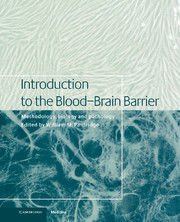Book contents
- Frontmatter
- Contents
- List of contributors
- 1 Blood–brain barrier methodology and biology
- Part I Methodology
- 2 The carotid artery single injection technique
- 3 Development of Brain Efflux Index (BEI) method and its application to the blood–brain barrier efflux transport study
- 4 In situ brain perfusion
- 5 Intravenous injection/pharmacokinetics
- 6 Isolated brain capillaries: an in vitro model of blood–brain barrier research
- 7 Isolation and behavior of plasma membrane vesicles made from cerebral capillary endothelial cells
- 8 Patch clamp techniques with isolated brain microvessel membranes
- 9 Tissue culture of brain endothelial cells – induction of blood–brain barrier properties by brain factors
- 10 Brain microvessel endothelial cell culture systems
- 11 Intracerebral microdialysis
- 12 Blood–brain barrier permeability measured with histochemistry
- 13 Measuring cerebral capillary permeability–surface area products by quantitative autoradiography
- 14 Measurement of blood–brain barrier in humans using indicator diffusion
- 15 Measurement of blood–brain permeability in humans with positron emission tomography
- 16 Magnetic resonance imaging of blood–brain barrier permeability
- 17 Molecular biology of brain capillaries
- Part II Transport biology
- Part III General aspects of CNS transport
- Part IV Signal transduction/biochemical aspects
- Part V Pathophysiology in disease states
- Index
7 - Isolation and behavior of plasma membrane vesicles made from cerebral capillary endothelial cells
from Part I - Methodology
Published online by Cambridge University Press: 10 December 2009
- Frontmatter
- Contents
- List of contributors
- 1 Blood–brain barrier methodology and biology
- Part I Methodology
- 2 The carotid artery single injection technique
- 3 Development of Brain Efflux Index (BEI) method and its application to the blood–brain barrier efflux transport study
- 4 In situ brain perfusion
- 5 Intravenous injection/pharmacokinetics
- 6 Isolated brain capillaries: an in vitro model of blood–brain barrier research
- 7 Isolation and behavior of plasma membrane vesicles made from cerebral capillary endothelial cells
- 8 Patch clamp techniques with isolated brain microvessel membranes
- 9 Tissue culture of brain endothelial cells – induction of blood–brain barrier properties by brain factors
- 10 Brain microvessel endothelial cell culture systems
- 11 Intracerebral microdialysis
- 12 Blood–brain barrier permeability measured with histochemistry
- 13 Measuring cerebral capillary permeability–surface area products by quantitative autoradiography
- 14 Measurement of blood–brain barrier in humans using indicator diffusion
- 15 Measurement of blood–brain permeability in humans with positron emission tomography
- 16 Magnetic resonance imaging of blood–brain barrier permeability
- 17 Molecular biology of brain capillaries
- Part II Transport biology
- Part III General aspects of CNS transport
- Part IV Signal transduction/biochemical aspects
- Part V Pathophysiology in disease states
- Index
Summary
Introduction
The endothelial cells of cerebral capillaries are joined by tight junctions that impede paracellular movement of solutes. Therefore, nutrients and ions must be transported across the respective luminal (blood-facing) and abluminal (brain-facing) plasma membranes (Brightman and Reese, 1969; Pardridge, 1983). These membranes are structurally and functionally different, resulting in a polarized configuration typical of epithelial cells (Betz and Goldstein, 1978; Betz et al., 1980). Such an arrangement favors net unidirectional transport of certain solutes across the barrier, and implies that transendothelial flux is a balance of events occurring at each membrane domain (Ennis et al., 1996). Clearly, the properties of both membranes must be defined and distinguished to characterize the blood–brain barrier properly. A technique is here in described for the isolation of enriched luminal and abluminal plasma membranes. Because these membranes spontaneously form tightly sealed vesicles, they can be used to study the transport and enzymatic properties of each side of the blood–brain barrier separately.
Isolation of luminal and abluminal plasma membrane vesicles from the blood–brain barrier
Plasma membrane vesicles from bovine cerebral capillary endothelial cells are isolated in two stages. During the first phase, brain microvessels are isolated as described by Pardridge in Chapter 6.
- Type
- Chapter
- Information
- Introduction to the Blood-Brain BarrierMethodology, Biology and Pathology, pp. 62 - 70Publisher: Cambridge University PressPrint publication year: 1998
- 6
- Cited by



